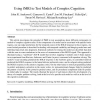Free Online Productivity Tools
i2Speak
i2Symbol
i2OCR
iTex2Img
iWeb2Print
iWeb2Shot
i2Type
iPdf2Split
iPdf2Merge
i2Bopomofo
i2Arabic
i2Style
i2Image
i2PDF
iLatex2Rtf
Sci2ools
COGSCI
2008
2008
Using fMRI to Test Models of Complex Cognition
This article investigates the potential of fMRI to test assumptions about different components in models of complex cognitive tasks. If the components of a model can be associated with specific brain regions, one can make predictions for the temporal course of the BOLD response in these regions. An event-locked procedure is described for dealing with temporal variability and bringing model runs and individual data trials into alignment. Statistical methods for testing the model are described that deal with the scan-to-scan correlations in the errors of measurement of the BOLD signal. This approach is illustrated using a "sacrificial" ACT-R model that involves mapping 6 modules onto 6 brain regions in an experiment from Ravizza, Anderson, and Carter (in press) concerned with equation solving. The model's visual encoding predicted the BOLD response in the fusiform gyrus, its controlled retrieval predicted the BOLD response in the lateral inferior prefrontal cortex, and it...
BOLD Response | Brain Regions | COGSCI 2008 | Model |
| Added | 25 Dec 2010 |
| Updated | 25 Dec 2010 |
| Type | Journal |
| Year | 2008 |
| Where | COGSCI |
| Authors | John R. Anderson, Cameron S. Carter, Jon M. Fincham, Yulin Qin, Susan M. Ravizza, Miriam Rosenberg-Lee |
Comments (0)

